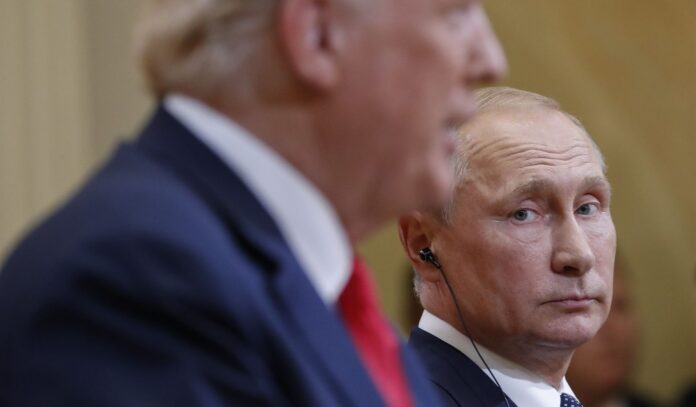President Trump has reportedly given Ukrainian President Volodymyr Zelensky the go-ahead to strike targets deep inside Russia using U.S. weaponry.
According to the report, the conversation took place during a telephone call between Trump and Putin on July 3, which left Trump feeling that Putin wasn’t very interested in any peace plan that did not involve reducing Ukraine to a Russian vassal state. In that call, Putin made it clear that he intended to pursue Russian war aims.
The following day, Trump and Zelensky reportedly had a call in which Trump urged Zelensky to “make them [the Russians] feel the pain.”
Two people familiar with the conversation between Trump and Zelenskyy said the US president had asked his Ukrainian counterpart whether he could hit military targets deep inside Russia if he provided weapons capable of doing so.
“Volodymyr, can you hit Moscow? . . . Can you hit St Petersburg too?” Trump asked on the call, according to the people.
They said Zelenskyy replied: “Absolutely. We can if you give us the weapons.”
Trump signalled his backing for the idea, describing the strategy as intended to “make them [Russians] feel the pain” and force the Kremlin to the negotiating table, according to the two people briefed on the call.
The White House issued some mild pushback on the story that, in my view, amounts to a non-denial denial.
The White House insisted in a statement to The Post that the comments should not be taken out of context, with press secretary Karoline Leavitt pushing back on the Financial Times’ framing of the call, which suggested Trump encouraged Zelensky to step up strikes deep into Russian territory.
“The Financial Times is notorious for taking words wildly out of context to get clicks because their paper is dying,” Leavitt told The Post.
“President Trump was merely asking a question, not encouraging further killing. He’s working tirelessly to stop the killing and end this war.”
Note that the White House response is missing either a denial that the call took place or that Trump told Zelensky to “make them feel the pain.” Instead, we’re supposed to assume that “feel the pain” meant calling the Russians bad names or blocking them on Instagram and not striking deep targets.
The events of the past few days have added more details to the events. When NATO Secretary General Mark Rutte visited the White House on Monday, Trump issued a 50-day deadline for Putin to come to the bargaining table. This was a change from the non-operative two-week deadlines that preceded it on at least two occasions (April 27 and May 14). Not only did Trump threaten Putin’s Russia with punishing secondary sanctions, which have so far been off the table, he also changed direction on Pentagon weapons sales from the, in my view, ill-advised Pentagon decision to discontinue sending arms to Ukraine.
The new method of arming Ukraine by selling weapons to the Europeans for donation to Ukraine, or to fill European stocks, while sending older equipment and munitions to Ukraine, gives a fig leaf to the Pentagon architects of weapons moratorium rather than open repudiation. The Europeans buying our weapons does nothing more to relieve the shortages of ammunition cited by the Pentagon than sending them to Ukraine directly. As any transfer of U.S. weapons and munitions requires our approval, we are still openly arming Ukraine.
READ MORE: Trump Reveals How His Latest Phone Call With Putin Went, and It’s Not Good
Russian Officials Smugly Dismiss Trump’s ‘Theatrical Ultimatum’ on Ukraine Ceasefire Deal
This followed an announcement on Friday that Germany would fund the production of long-range missiles based on a design developed in Ukraine.
Ukraine will begin receiving hundreds of domestically produced long-range weapon systems by the end of July under a German-financed agreement, German Major General Christian Freuding told the German ZDF news channel on July 11.
The weapons will be supplied in a “high triple-digit quantity,” he said, referring to a deal between Ukraine’s Defense Ministry and local arms producers that Berlin agreed to fund in late May.
“We need weapons systems that can reach far into the depth of Russian territory — to hit depots, command centers, airfields and aircraft,” Freuding said, adding that Germany is “ready to provide such systems.”
The statement likely refers to the Neptune R-360 missile, which has a range exceeding 600 miles and has seen combat use.
In the past, Germany has refused to provide Ukraine with any weapon system that the U.S did not match. Where Britain and France have transferred their Storm Shadow and SCALP EG cruise missiles to Ukraine, Germany resolutely refused to release Taurus even after the U.S. gave ATACMS to Ukraine.
Even though Trump seemed to give Putin a deadline, one which the Russians ruthlessly mocked, I’d point out that the Axios report of Trump’s July 3 call with Putin has Putin saying he has a 60-day offensive plan in which he hoped to take the administrative boundaries of the four Ukrainian provinces he has annexed. Putin’s 60 days and Trump’s 50 days are about 10 days apart (July 3 and July 14).
Whether Trump’s suggestion to Zelensky marks a new combativeness in a strangely docile Trump as it relates to Putin, or it is part of a negotiation scheme to convince Putin to come to the table, remains to be seen. We’ll only know that when Trump’s 50-day deadline expires and the war is still going full bore, and he has to either deliver on his ultimatum or follow the Tik-Tok model and give Putin more time.
Editor’s Note: This article was updated post-publication for clarity.
RedState is your leading source for news and views on administration, politics, culture, and conservatism. If you like our reporting and commentary, please become a member and support our efforts. Use promo code FIGHT to get 60% off your membership.




